Aotearoa’s amphibians are not your typical frogs. Think of everything you know about frogs and chances are New Zealand’s native frogs do things differently. Frogs croak loudly right? Not ours. Frogs lay eggs that hatch into tadpoles? Nope – our frogs don’t do tadpoles either.
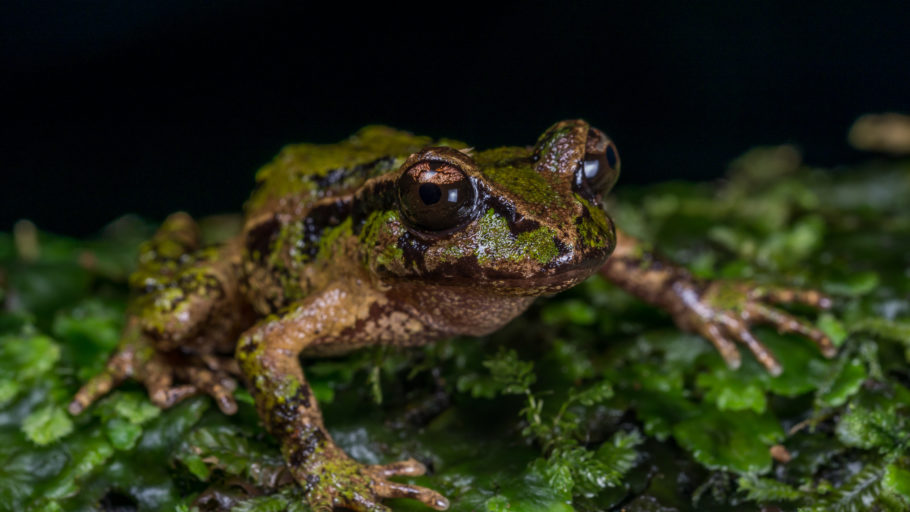
Other frogs have slitty eyes but not Aotearoa’s. Their eyes are round. Catch insects by flicking out their tongue – not ours. Most of our frog species don’t even have webbed feet. The list goes on…
So why are our frogs so unfroglike – and what do they do instead?
It turns out that our frog species belong to an ancient and primitive family that no longer exists anywhere else in the world. They haven’t changed much in 70 million years! So our frogs come from a time before frogs developed some of the ‘typical’ frog features we recognise today. They don’t even live in ponds!
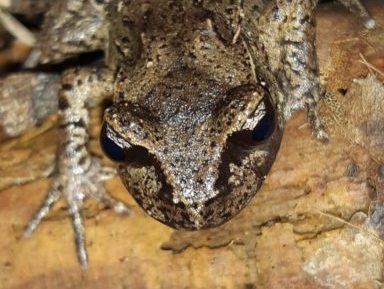
New Zealand has 4 frog species, although 2 of those species are very similar: Hochstetter’s, Archey’s, Hamilton’s – all found in the North Island – and the Maud Island frog which is a lot like Hamilton’s but slightly smaller and only found on Maud Island in the Marlborough Sounds. All belong to the genus Leiopelma.
In pre-human times we had 7 species spread throughout Aotearoa. Actually there are still 7 frog species in New Zealand – but the other 3 species we have now are modern-day introductions from Australia. The newcomers are ‘typical’ frogs – they croak loudly to attract a mate, have webbed feet and go through a tadpole stage. All very ordinary really.
But our Leiopelma endemics – they’re something special.
Our native frogs catch insects by gulping them with their mouth – not flicking out a long tongue. Sometimes they use their arms as well. They have an extra vertebrae compared to other frogs and no external eardrums – which fits with not croaking. A good sense of hearing isn’t important when you have other ways of communication.
It’s not that they’re totally silent. They have some vocalizations, but they don’t croak. There are no mating calls and the only noises that any of the four species are known to make are chirps or yelps when harassed. It is currently thought that these frogs communicate more like salamanders (another type of amphibian) than other frogs, using chemosignals to recognize size and individuality of other individuals. For example, the Maud Island frog can respond to the scent cues in frog faeces.
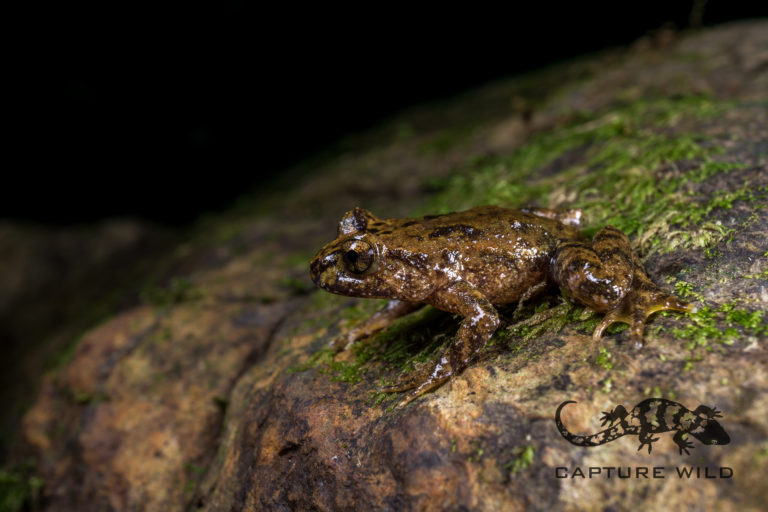
Like all amphibians, our frogs need to keep their skin moist to breathe – but that doesn’t mean they live in ponds. Some live on misty ridges, far from wetlands and streams. Only Hochstetter’s frogs live near water – they’re our only native frog which has partial webbing behind their hind toes. The other species keep damp in moist, shady places in the forest or amongst rocks. They’re nocturnal and during the day they hide under logs, stones and bushes. Archey’s frogs can climb several metres up trees.
None of our frog species lays their eggs in water and, since they don’t live in ponds, freeswimming tadpoles aren’t a life-stage option. All four native species produce very large yolky eggs (between 1 and 22, depending on species). Female Hochstetter’s frogs lay their eggs under stones or fallen vegetation and don’t provide any parental care – the tailed froglets hatch out, absorb the yolk, and resorb (assimilate) their tail. Then they’re on their own.
The other three Leiopelma have very similar behaviour to eachother. Females lay small clutches of large eggs, which the males sit over until they hatch. Young froglets, complete with yolk sac and tails, climb onto the male’s back and stay there for a month or longer until they become independent. Such care may keep the youngsters moist, reduce predation and possibly reduce fungal or microbial infections.
If they can avoid predators and other natural hazards, our native frogs can live along time – up to 30 years in some cases.
Hamilton’s frog is one of the rarest frogs in the world with less than 300 individuals remaining. It is mainly restricted to a 600-square-metre boulder bank on Stephens Island in Cook Strait – surely the smallest known habitat for any frog. Being adapted to rocky ground, its feet have almost no webbing. Fossil records show it was once spread from Waikato to Punakaiki.
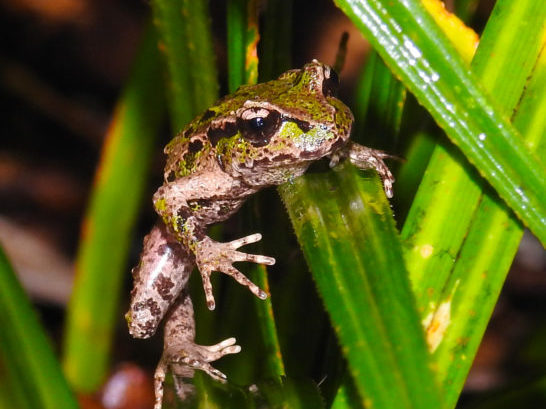
In 1997, 300 Maud Island frogs were successfully transferred to Motuara Island – the first-ever translocation of a native frog between islands and they are now found on several predator-free islands in the Marborough Sounds. The latest estimate of the number of individuals of this species is around 40,000, with the Maud Island frog reaching densities of five frogs per square metre in suitable places.
It’s a case of ‘Home Sweet Home’ for Maud Island frogs which tend to stay with a 5m radius for years at a time. They are very long lived with some individuals being found thirty years after they were marked.
Archey’s frog is our smallest native frog, growing up to 37 mm long and is recognised as the world’s most evolutionarily distinct and globally endangered amphibian. It’s a modern-day dinosaur – almost unchanged from 150 million years ago and one of the world’s oldest frogs. It occupies damp forest habitats above 400 metres, but has been found as low as 100-200 m above sea level in the Coromandel. The Whareorino Forest population in the King Country, discovered in 1991, may spend more time in trees than the Coromandel groups.
Populations of Archey’s frog have crashed in recent years with monitored populations decreasing by 88% over the 1996-2001 period. Several factors, including the severity and rapidity of the population crash, the geographic spread of the decline (from south to north), and the discovery of frogs with chytridiomycosis (caused by Batrachochytrium dendrobatidis), all point to disease being the major cause of the decline. A breeding facility has been opened at Auckland Zoo which aims to produce a self-sustaining captive population.
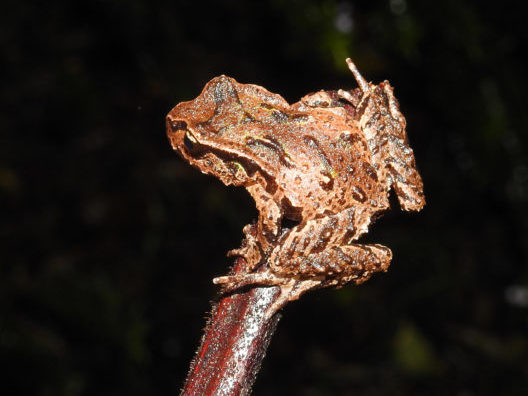
Hochstetter’s frog is the most widespread native frog and has been sighted around the upper half of the North Island, including at Waipu, Great Barrier Island, the Coromandel, central North Island, and the Raukumara Ranges. It is generally dark brown, grows up to 48 mm long, has partially webbed feet and has more warts than the other native frogs. Its also the most aquatic – albeit only semi-aquatic – of our native frogs.
One of the main threats to this species is the destruction and modification of its habitat, which is still occurring either directly (e.g. afforestation, gold mining, storm water discharge) or indirectly (e.g. feral goats and pigs causing erosion leading to stream siltation).
Being small, all our native frogs are vulnerable to predators, including other native wildlife and introduced predators such as rats. But they’re not without their own unique forms of defence – some techniques more effective than others.
When tiny Archey’s and Hochstetter’s frogs were picked up by a weka, the frogs gave off high-pitched squeaks until the weka dropped them. The Archey’s frogs then stood their ground with a head-butting posture, which further discouraged the large bird. Unfortunately, introduced rats and other predators are not so easily put off.
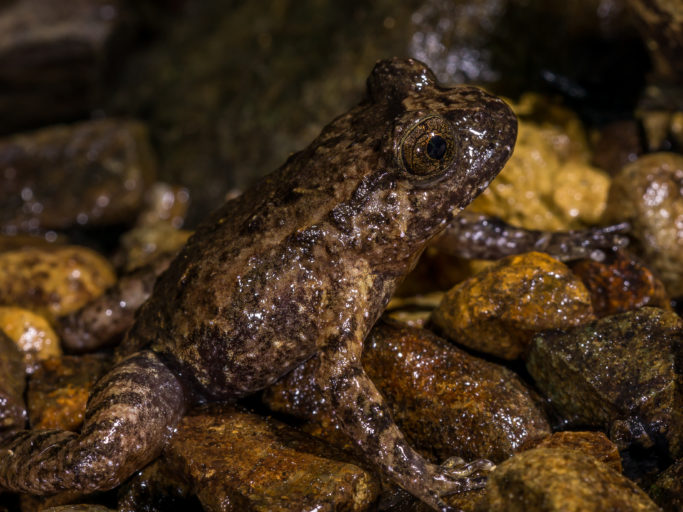
Five dead Archey’s frogs found in the Whareorino Forest showed signs of attack by rats – but the rats left the heads of their victims intact. The frogs have defensive glands around the head and backs that secrete compounds that may be bitter or toxic. Other evidence, largely anecdotal, suggests that native predators as varied as the giant kōkopu (a fish), tuatara (reptile) and weka (bird) may avoid the native Leiopelma frogs, perhaps because of the defensive compounds.
Disease is also a serious threat. Over the past 25 years amphibian populations have declined throughout the world and disease is considered to play a major role. Amphibian chytrid fungus is a disease that is in New Zealand and a major threat to frogs worldwide.
The fungus has been confirmed in introduced frog populations all over New Zealand and in native frog populations on the Coromandel Peninsula and in the Whareorino Forest. The fungus relies on damp conditions to survive and to spread. It can be spread from frog to frog contact or through contact with infected soil and water. People, animals or vehicles can spread the amphibian chytrid fungus by moving soil and water around on their boots, gaiters or equipment.
You can help our native frogs – even without ever seeing them. Avoid spreading the amphibian chytrid fungus by avoiding visits to areas where native frogs are found and if you do need to visit native frog habitat, ensure all your footwear, gaiters and equipment are clean and disinfected. Avoid touching frogs, because you may damage their sensitive skin. If you have a permit to touch them, make sure your hands are wet.
Find out more about New Zealand’s native frogs.

